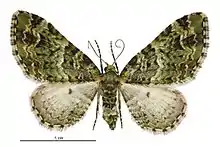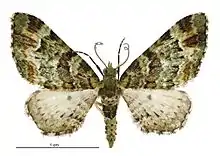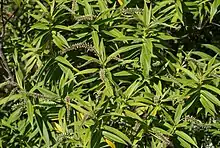Pasiphila bilineolata
Pasiphila bilineolata is a moth in the family Geometridae. It is endemic to New Zealand and can be found in the North and South Islands. The species inhabits native forest and shrubland and the larvae feed on Hebe species. Adults are on the wing commonly from August to January but have been observed most months of the year and are attracted to light.
| Pasiphila bilineolata | |
|---|---|
 | |
| Female specimen | |
 | |
| Male specimen | |
| Scientific classification | |
| Domain: | Eukaryota |
| Kingdom: | Animalia |
| Phylum: | Arthropoda |
| Class: | Insecta |
| Order: | Lepidoptera |
| Family: | Geometridae |
| Genus: | Pasiphila |
| Species: | P. bilineolata |
| Binomial name | |
| Pasiphila bilineolata | |
| Synonyms[2] | |
| |
Taxonomy
This species was first described by Francis Walker in 1862 and named Eupithecia bilineolata.[3] Walker used a specimen collected by T. R. Oxley in Nelson.[3][2] In 1888 Edward Meyrick placed this species in the genus Pasiphila.[4] In 1898 and again in 1928 George Hudson discussed and illustrated this species under the name Chloroclystis bilineolata.[5][6] In 1971 John S. Dugdale placed this species back in the genus Pasiphila.[7] In 1988 Dugdale confirmed this placement and also synonymised Chloroclystis lacustris, Chloroclystis paralodes and Chloroclystis zatricha with this species.[2] Robert Hoare, in the New Zealand Inventory of Biodiversity, followed this placement.[8] The female holotype specimen is held at the Natural History Museum, London.[2]
Description

Walker described the species as follows:
Female. Greenish cinereous. Palpi obliquely ascending, as long as the breadth of the head. Thorax with two black points on each side. Abdomen slightly crested, with a broad blackish band near the base. Wings rather broad, with several brown denticulated lives, some of which, and especially in the fore wings, are clouded or pointed with black; submarginal line whitish, zigzag; marginal points black, elongated. Fore wings slightly acute, with a fawn coloured tinge at the base, and with a black discal point. Hind wings reddish cinereous. Length of the body 4 lines; of the wings 12 lines.[3]
The forewings are bright green with numerous wavy darker lines. The hindwings are grey, slightly tinged with reddish. Adults are on wing from September to May.[5]
Distribution
This species is endemic to New Zealand.[1] This species has been observed in the North and South Islands.[9]
Behaviour
This species is on the wing mainly from August to January but observations have also been recorded in February, April, May and June.[10] This species is attracted to light.[11]
Habitat and hosts

The larvae feed on the flowers and foliage of Hebe species.[12] Adults of this species inhabit native forest and shrublands.[6][13] Adult moths have been observed feeding on the flowers of Dracophyllum acerosum, Dracophyllum uniflorum and Veronica salicifolia.[14]
References
- "Pasiphila bilineolata (Walker, 1862)". www.nzor.org.nz. Landcare Research New Zealand Ltd. Retrieved 15 May 2018.
- John Stewart Dugdale (23 September 1988). "Lepidoptera - annotated catalogue, and keys to family-group taxa". Fauna of New Zealand. Department of Scientific and Industrial Research. 14: 188. doi:10.7931/J2/FNZ.14. ISSN 0111-5383. Wikidata Q45083134.
- Francis Walker (1862), List of the Specimens of Lepidopterous Insects in the Collection of the British Museum, XXIV: Geometrites (continued), vol. 24, p. 1246, Wikidata Q109609883
- Edward Meyrick (May 1888). "Notes on New Zealand Geometrina". Transactions and Proceedings of the New Zealand Institute. 20: 50–51. ISSN 1176-6158. Wikidata Q108281219.
- George Vernon Hudson (1898), New Zealand moths and butterflies (Macro-lepidoptera), Illustrator: George Hudson, London, p. 41, doi:10.5962/BHL.TITLE.7912, OCLC 980865393, Wikidata Q19073637
{{citation}}: CS1 maint: location missing publisher (link) - George Vernon Hudson (1928), The butterflies and moths of New Zealand, Illustrator: George Hudson, Wellington, p. 91, LCCN 88133764, OCLC 25449322, Wikidata Q58593286
{{citation}}: CS1 maint: location missing publisher (link) - J. S. Dugdale (10 November 1971). "Entomology of the Aucklands and other islands south of New Zealand: Lepidoptera, excluding non-crambine Pyralidae" (PDF). Pacific Insects Monographs. 27: 106. ISSN 0078-7515. Wikidata Q64006453.
- Gordon, Dennis P., ed. (2010). New Zealand inventory of biodiversity: Kingdom animalia : chaetognatha, ecdysozoa, ichnofossils. Vol. 2. p. 460. ISBN 978-1-877257-93-3. OCLC 973607714. OL 25288394M. Wikidata Q45922947.
- "Pasiphila bilineolata". www.gbif.org. Retrieved 2022-05-13.
- Alan Emmerson; Robert Hoare (28 October 2019). "Lepidoptera from Redvale, Albany, north of Auckland, New Zealand, 2004-2016: an annotated list". The Wētā. 53: 43–70. ISSN 0111-7696. Wikidata Q105342215.
- Curtis, Kate (2016). Assessing the invertebrate fauna trajectories in remediation sites of Winstone Aggregates Hunua quarry in Auckland. Mike Bowie, Keith Barber, Stéphane Boyer, J. W. M. Marris and Brian Patrick. Christchurch, New Zealand: Department of Conservation. p. 47. ISBN 978-0-86476-417-1. OCLC 1224171847.
{{cite book}}: CS1 maint: date and year (link) - Patrick, H.J.H.; Bowie, M.H.; Fox, B.W.; Patrick, B.H. (2011). "The moths of Quail Island (Otamahua): a faunal comparison of an island under restoration with other sites on Banks Peninsula" (PDF). New Zealand Natural Sciences Journal. 36: 57–72. Archived from the original (PDF) on 2016-03-03. Retrieved 2018-05-15.
- Brian H. Patrick (1994), Coastal butterflies and moths of Wellington and South Wairarapa. (PDF), Wikidata Q110426707, archived from the original (PDF) on 13 December 2021
- Richard B. Primack (July 1983). "Insect pollination in the New Zealand mountain flora". New Zealand Journal of Botany. 21 (3): 317–333. doi:10.1080/0028825X.1983.10428561. ISSN 0028-825X. Wikidata Q54669862.